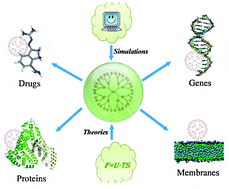Theoretical and computational studies of dendrimers as delivery vectors†
Abstract
It is a great challenge for nanomedicine to develop novel dendrimers with maximum therapeutic potential and minimum side-effects for drug and gene delivery. As delivery vectors, dendrimers must overcome lots of barriers before delivering the bio-agents to the target in the cell. Extensive experimental investigations have been carried out to elucidate the physical and chemical properties of dendrimers and explore their behaviors when interacting with biomolecules, such as gene materials, proteins, and lipid membranes. As a supplement of the experimental techniques, it has been proved that computer simulations could facilitate the progress in understanding the delivery process of bioactive molecules. The structures of dendrimers in dilute solutions have been intensively investigated by monomer-resolved simulations, coarse-grained simulations, and atom-resolved simulations. Atomistic simulations have manifested that the hydrophobic interactions, hydrogen-bond interactions, and electrostatic attraction play critical roles in the formation of dendrimer–drug complexes. Multiscale simulations and statistical field theories have uncovered some physical mechanisms involved in the dendrimer-based gene delivery systems. This review will focus on the current status and perspective of theoretical and computational contributions in this field in recent years. (275 references)


 Please wait while we load your content...
Please wait while we load your content...